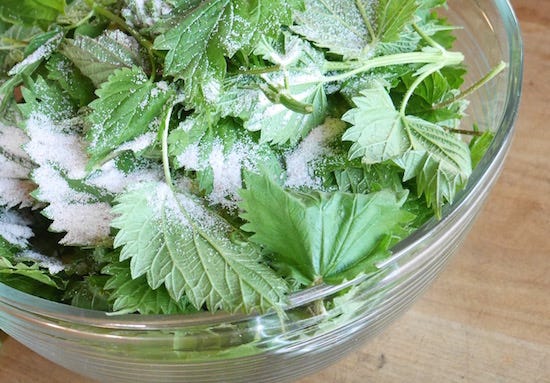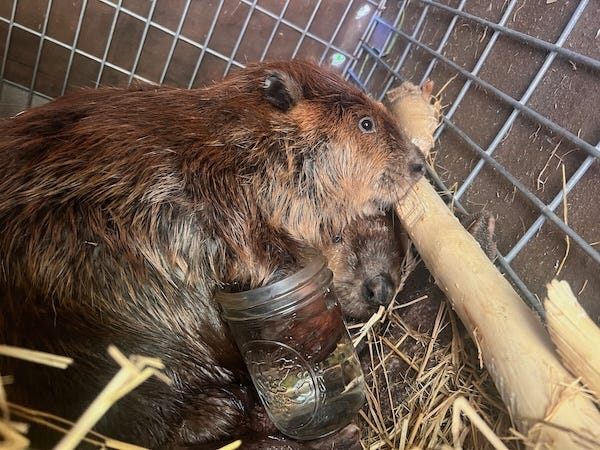The Delights (and overwhelming business) of Spring
Grass, beaver rehabilitation (cute video warning), fermenting nettles, and more
A friend told me this morning. “I am not behind, Nature is just ahead of me,” referring mostly to the act of putting in a garden this year. I could relate. I feel that way about everything that could, should, or needs to be done around here as the lush growth and dynamic energy of this vernal season simultaneously overwhelms and delights me.
Overwhelms
In the last weeks and the weeks to come every free moment is spent knocking back the annual grasses (non-native) with common names like Medusahead, Foxtails, Softbearded Oat Grass, Cheat Grass, and Wild Oats. These and many more grasses have grown thick and tall this year thanks to a moist early Spring. The seed heads stick to socks and worm their way into our pet’s ears. They are not food for wildlife or nectar for pollinators but out-compete the meadow species that are. And most pressing as they begin to brown is that they are wildfire fuel. Our home is surrounded by these difficult grasses because the century or so before we were here the forest was cleared and sheep grazed the soils bare year after year. A quarter of a century of our attempts at restoration has brought back a few small patches of native clumping grass and many 🌲 trees. Someday these trees might shade most of them out. Nature moves both fast and slow.
Getting the garden planted for future ferments. (🍅🫑🫛🥦🍆🥒🥬🌶️)
Ridding our closet of a moth infestation.
Delights
Nettles.
Each year I look forward to the nettles so that I can make a gallon of fermented nettle kraut. They are on and I headed to the creek with snips and a basket, wearing long sleeves and good gloves. Our creeks in Western Oregon are choked with Himalayan Blackberries, as are the fence lines and fields; I swear these canes even swallow abandoned buildings. A number years ago 1.7 miles of neighbors along Thompson Creek cooperated and agreed to an ambitious riparian restoration project. The first part of this rehabilitation was to simply cut down the blackberries. It was fascinating to see the land reveal itself under the bramble. An area below our house exposed a few rusted-out early twentieth-century car bodies and a wonderful patch of nettles. The canes are back (overwhelm) but I head in every year hacking a path through the brambles and slashing back new blackberry canes while gently snipping nettles.
Nettles ferment beautifully. And I already can tell a lot of you are thinking—what about the sting? I promise, once fermented there is no sting. Let’s take a moment to look at how the stinging part works.
Nettles have tiny hairs on the underside of their leaves and on their stems. When the little hairs are touched the tip of the hair breaks off leaving a microscopic hollow needle—think a hypodermic needle. Behind this needle is a wee reservoir of the nettles plant chemicals—histamine, acetylcholine, serotonin, and formic acid—the dose that is then injected into whoever happened to brushed by. Ouch. But that is also some powerfully good stuff. Nettle is a powerful antihistamine that is used by people who suffer from allergies. The formic acid and acetylcholine stimulate capillaries and improve blood flow. The list of uses throughout the world is quite long.
So the part that burns is in truth quite delicate. Cooking breaks the cells. Drying, well, dries up this liquid dose of plant chemicals, removing the water and keeping the compounds. When we ferment nettle we start by bruising them while massaging with salt after fermentation the structure that stings in also inert.


When prepping the nettles wear gloves. The first time I tried submerging whole nettle leaves and stems in salt water overnight (as one would do with Napa cabbage for kimchi) I was surprised to find them capable of stinging the next morning. While salt tends to help break the cell walls and dehydrate plant juices from the vegetable being pickled this did not deactivate those little needles immediately. It is the combination of bruising, salt and time that disables the sting.
One important nettle fermentation tip is that this green generally doesn’t have a high enough carbohydrate content for the fermentation to reach the important pH marker of 4.6 or below. All this means is don’t ferment nettles solo. Instead, ferment nettles with other vegetables. Their sugar content will feed the lactic acid bacteria and bring that acid level down.
Birds
My other delight at the moment are all the birds singing and calling to each other from the first light of dawn until evening twilight. I might be a little late to the game but the Merlin app from Cornell Ornithology has helped know who is out there. The other evening at dinner I let the app record while we ate dinner outside. In a half hour, 26 birds had serenaded us at different points in the meal. Okay, I’ll be honest it has become a tiny obsession. I knew this when Christopher called me a nerd this morning when I was going on and on about the morning list of friends.
Both
Beverly the beaver. A few days shy of two months ago a pregnant female beaver came to live in our pond. To be clear, while it is a lovely pond, it wasn’t her choice to move in. She and her mate had set up a home in the bank of a local irrigation canal and were awaiting the birth of their first children. Not ideal beaver habitat but a starter home nonetheless and I am sure they were happy. She had been caught for 24 hours in a leg hold trap meant to drown her. My son rescued her after the woman who’d spotted her was told by local wildlife officials that they wouldn’t do anything but here is the number for a “crazy beaver guy” who might help. Jakob rescued her and a few days later he was able to humanely live-trap her mate (beavers mate for life) which was good for her overall morale and well-being.
Beverly and Joe Travis grooming after being reunited.
Jakob and I have treated many animals together—both wild and domestic. When Jakob was six years of age he decided he wanted to be a wildlife vet when he grew up. He was all consumed with the idea. I took him to our local wildlife rehabilitation center. He wanted to volunteer. He was too young to come on his own, but they would allow me to volunteer and bring him along some of the time. Just when I thought as a homeschooling mother of three little boys I couldn’t fit one more thing in my life I added wildlife rehab volunteer to my schedule. I went every Sunday evening for the next year. I mostly fed injured birds of prey which is a gift that I still hold tight in my memory—especially the three juvenile barn owls who swayed in unison as one when being fed. That was the beginning. But I digress…
This arm injury girdled her wrist—we could see severed tendons and exposed bones. That was the first day of many overwhelming moments of cleaning and caring for the wound. She was seen by a vet but given her pregnant state there was nothing he could do that wouldn’t jeopardize her life. So we clean her wound, soak it in a salt solution, and give her antibiotics (and a probiotic) twice a day. (In case you ever need to give antibiotics to a beaver – they are rodents and cannot have what dogs, cats, or livestock can. It took two weeks to get the first dose made as the ingredients for the formula had to be ordered.)

The delight is in the wonder that comes with sitting quietly with a beaver at the edge of a pond. Being forced to slow down and spend time seated quietly, observing and listening, when normally my mind is rushing through the to-dos has been challenging and good. This pond is just 20 or so yards from our home but the amount of life happening at its edges at the twilight edges of the day is remarkable. Dragonflies and other insects dip down for a sip of water while flycatchers dart in, hoping for a meal. In the morning Western Pond Turtles hauling out to warm in the sun. In the evening the tree frogs begin their chorus of calls. Her mate, now named Joe by our grandchildren, is wary but cute as he watches us tend her. He also is sure to give us a hardy tail slap if we move too quickly.
Beverly’s wound is still far from healed. We now can feel her babies kick now when we sit quietly with her. I am super excited for the babies—because baby beavers are one of the cutest things—but am also hoping she heals more before they arrive. The more she is healed the less we will have to interfere with the early days of motherhood.
Fermentation read
I will leave you today with a article that came out in Nature this past week.
Have you heard of the Guizhou cactus pear (Rosa roxburghii Tratt)? Actually not a cactus at all. It is in the rose family (apples, pears, haws, and so on) and looks like a prickly yellow rose hip. I hadn’t heard of it until reading this article on how fermentation enhances the taste of this nutritionally packed fruit. I find this interesting as both someone who is fascinated by all the amazing plants on this planet and their properties as well as how fermentation often enhances. However, I have mixed feelings when it comes to a traditional local food (quinoa, acai, etc.) taking the stage in a way that often has unintended consequences both culturally, economically and environmentally.
“Now, food scientists are finding ways to refine and repurpose the technique to create new types of food.” Lines like this from the Nature article on the Guizhou fruit give me pause. I’d love to hear your thoughts on this, or anything related to your springtime joys or overwhelms. Leave a comment below.





Kirsten ... you and Jakob are blessings to the beavers. I'll include Beverly and Joe in my morning mediations for healing as these two need all the support they can garner. Please keep us updated on the delivery and Beverly's leg recovery. Those front appendages are so critical to dam building!
Wonderful! thanks for the tips regarding fermenting nettles. I will be def trying this out this summer.